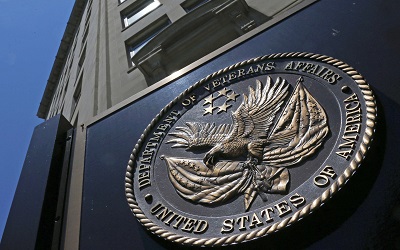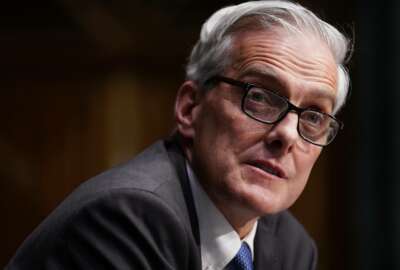Hubbard Radio Washington DC, LLC. All rights reserved. This website is not intended for users located within the European Economic Area.
VA takes to the streets and byways to meet at-risk veterans
The Veterans Affairs Department has long had a nationwide network of facilities so it could be close to those it serves. But now it's taking that a step further...
The Veterans Affairs Department has long had a nationwide network of facilities so it could be close to those it serves. But now it’s taking that a step further, with a fleet of mobile medical units on wheels. VA hopes to reach homeless or other veterans who just can’t get to a medical center. For the details, Federal Drive with Tom Temin spoke with Jillian Weber, VA’s national program manager for homeless patient-aligned care teams.
Interview Transcript:
Tom Temin Well, tell us what’s going on here. VA is putting out itself on wheels to local communities?
Jillian Weber That’s correct. VA is launching 25 mobile medical units to VA medical centers across the system to provide health care, mental health, women’s health and housing resources to veterans experiencing homelessness and those at risk of homelessness.
Tom Temin Well, I remember as a kid they had bookmobile, which were little libraries on wheels. Is this going to bring medical care to the homeless or is it going to bring the homeless back to a medical care facility and then drop them off again?
Jillian Weber These mobile units will bring medical care directly to veterans in the community setting. They will have access to vaccinations, health assessments, health education, medications and housing resources directly in the community setting.
Tom Temin This sounds like a pretty big vehicle. It’s not like a micro bus with a couple people in. It sounds like something they can step up into, and it’s like a little environment on wheels.
Jillian Weber That’s correct. There’s actually two different sizes that are being deployed. One is a larger 27 foot vehicle that has two exam spaces, and also has a bathroom on board. The second vehicle is a little bit smaller at 21 foot and it has one space when you step in. But both of them have stepped up into it and swinging hinge doors for easy access with railings for safety.
Tom Temin Let me ask you this. Veterans Affairs generally knows where homeless veterans are. There are population surveys done, I think people get out on foot a couple of times a year and search out where the homeless veterans are living. What is the logistics of going to those areas and making sure that the people that show up to the van are, in fact Veterans Affairs Department worthy individuals?
Jillian Weber We have been very intentional and thoughtful about the outreach process using these vehicles. So this includes coordinating strongly with our community partners, along with all of our VA homeless program staff and primary care medical staff, in terms of reaching those individuals that are high need. So there has been extreme thought process into this planning stages.
Tom Temin Well, yeah. I mean, how do you I.D. the people when you get there, for example?
Jillian Weber So VA also coordinates with eligibility. The teams that go on the mobile unit will coordinate with their eligibility office to ensure they’re eligible for services.
Tom Temin I mean, if you are a veteran, you have usually documentary evidence of that fact, discharge papers or card, whatever it might be. And do the homeless generally have that? And if they don’t, then what happens?
Jillian Weber So veterans experiencing homelessness or those at risk sometimes have their paperwork and sometimes they don’t, just by the nature of their living situation they may not be carrying appropriate paperwork around with them. Therefore, the homeless program staff, the primary care medical team staff, really work with the veteran and they work with the community providers and the VA system as a whole to ensure these individuals are eligible, and really be able to provide that care onsite at that point in time as well.
Tom Temin And are the homeless only in the urban areas, as we commonly see with the tent cities and so forth popping up? Or what about the rural, either homeless or rural that are living in conditions such that it’s difficult for them to get to a VA or even a community care provider?
Jillian Weber That’s correct. There are homeless individuals in the urban areas, and that’s more what you’re speaking to what we see. But they are often found in the rural areas as well. That’s why we have to be very intentional and strategic about working with our community partners and making sure there’s broad awareness about the scheduling of the vehicle and sticking to that schedule when it is set as well.
Tom Temin We’re speaking with Jillian Weber. She’s national program manager for homeless patient aligned care teams at the Veterans Health Administration. And who staffs these vans? And how does that all come about to make sure you have the people necessary to deal with what they might encounter when they get to a location?
Jillian Weber The core staff on the vehicles will be the primary care team that is dedicated to providing service for homeless veterans, for the age packed team that you mentioned. So this will include a medical provider that could be a medical doctor, an advanced practice nurse practitioner or a physician’s assistant. It also includes nursing services, social work services and administrative support. In addition, there could be other disciplines present, in terms of pharmacy services, physical therapy, occupational therapy, and then, of course, key collaboration with our homeless program staff to provide that wrap around housing support.
Tom Temin What about the security aspects? Because some of the homeless zones are frankly dangerous spots.
Jillian Weber One of the key pieces of this is to ensure safety of veterans and of staff. So that includes ensuring there’s no one on the vehicle individually, we’re always working teams or partners to ensure their safety. And staff have also been trained and safety mechanisms to ensure that we all are kept safe. So really want to highlight that, I think that’s a key important piece that you mentioned, because we want staff and veterans alike to all be safe.
Tom Temin Because sometimes, people maybe have a psychological condition that renders the individual that you’re serving, someone you’ve got to be careful around, fair to say?
Jillian Weber Yes, that’s correct. And staff are trained in resources to support those individuals with mental health issues, substance abuse issues, things along those lines.
Tom Temin And what are some of the time of day challenges? Because, say, a homeless person could be in a shelter overnight, but then they’re out during the day. How do you make sure you get there at the location where you can really find them?
Jillian Weber The key piece in terms of accessing individuals and those veterans being able to access the mobile units is really the key collaboration with our community partners to operate at the emergency shelters or transitional housing programs to provide that awareness to us, if there is a new veteran on site that needs access to services. Because exactly that, the vehicles may not be functioning seven days a week, 24 hours a day available in the community setting. We really have to rely on that key collaboration with our partners.
Tom Temin Yeah, you come back to that point a lot. The community care partners are not necessarily suburban fancy medical clinics, but they could be people serving homeless populations right at the ground level, sounds like.
Jillian Weber That’s correct, yes. In the shelter systems or the transitional housing programs that are working to provide those resources. So food, shelter, clothing, all of those pieces that we really work collaboratively with to ensure the best for the veterans.
Tom Temin And what are some of the measures of success of this program? Just number of people served because you said vaccinations and so forth. But I mean, what if you identify someone that really needs hospitalization or needs more long-term care than they can get from the van?
Jillian Weber So the mobile vehicles act as an adjunct resource for those medical services. And since they’re staffed by the primary care medical team and other homeless service resources, they can easily make those referrals back to the VA medical center if they need to go to the emergency department, need to be admitted for various reasons. So that wraparound key piece is available since that staff from VA is staffing the vehicles.
Tom Temin And I guess if they were brought to a medical center for more extensive care or longer term care, would it be fair to say the services that could help them get out of the homeless situation might be more readily available and they could leave the VHA center to something other than the street?
Jillian Weber Ideally, if a veteran is admitted to the hospital, they will be provided those services as inpatient or in the emergency department or whatever aspect they’re in the actual hospital system to be able to facilitate housing and care outside of that stay. However, the vehicles provide that conduit to really help provide that key wraparound piece, in terms of so they don’t get lost in the system. There is no gap in care or gap in services.
Tom Temin And you’ve got 27 of these. Have you started with it or when do they start hitting the street, so to speak?
Jillian Weber We have 25 actually that will be deployed over the next six months. And the first one landed in Orlando on Aug.3.
Tom Temin OK. So they’re just out there. And is there a plan to say, well, if this works, you probably need more than 25 to cover the whole country?
Jillian Weber Yes. So right now, of course, we are focusing on the current launch of these 25 mobile medical units. However, there is lots of interest, of course, and future mobile units. And the next step of this phase is to really evaluate this program in the effectiveness of health outcomes. Then really taking those next steps forward into a future interest and planning for more vehicles.
Tom Temin And the vehicles that you have now, the 25, are they, so to speak, tethered to a particular medical center, for example, the Orlando Center or Albany or whatever it might be? That’s where they return at the end of the workday.
Jillian Weber That’s correct. They are awarded to 25 VA medical centers across the Bay System.
Tom Temin And how did you pick the 25, by the way?
Jillian Weber So the opportunity for a mobile medical unit was available to the 55 homeless primary care sites that operate out of the VA medical centers. Of those 55, 25 submitted complete applications and were awarded the mobile medical units.
Tom Temin So the plan is you hope that all 55 will have these at some point.
Jillian Weber At some point, that would be an ultimate goal in the future, yes.
Copyright © 2024 Federal News Network. All rights reserved. This website is not intended for users located within the European Economic Area.
Tom Temin
Tom Temin is host of the Federal Drive and has been providing insight on federal technology and management issues for more than 30 years.
Follow @tteminWFED
Related Stories
VA chief says increased outreach, utilization drove massive budget shortfall
Related Stories
-
Thousands of Vietnam veterans are missing out on VA benefits Veterans Affairs





